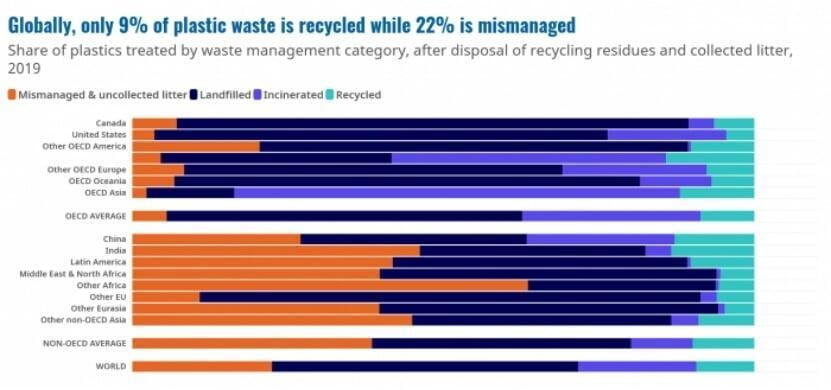According to a new report by the Organization for Economic Cooperation and Development (OECD), the world produces twice as much plastic waste as it did two decades ago, most of which ends up in landfills, incinerated or spilled into the environment, and only 9 percent is successfully recycled. Ahead of UN talks on international action to reduce plastic waste, the OECD's first Global Plastics Outlook shows that the amount of plastic used and discarded is increasing as populations and incomes rise, while policies to curb its leakage into the environment are not having the desired effect.
According to this report, almost half of the plastic waste is generated in OECD countries. The plastic waste generated per person per year ranges from 221 kilograms in the United States and 114 kilograms in European OECD countries to an average of 69 kilograms in Japan and South Korea.
Most plastic pollution comes from inadequate collection and disposal of larger plastic debris known as macroplastics, but leakage of microplastics (synthetic polymers less than 5 mm in diameter) from industrial plastic pellets, synthetic textiles, road signs, and tire wear, among others, is an equally serious problem.

OECD countries account for 14% of the overall plastic leakage. Of these, macroplastics account for 11 percent and microplastics account for 35 percent. The Outlook states that international cooperation to reduce plastic pollution should include support for low-income countries to develop better waste management infrastructure to reduce their plastic spills. The report found that the COVID-19 crisis led to a 2.2 percent decline in plastic use in 2020 as economic activity slowed, but the increase in litter, food take-out packaging and plastic medical devices such as masks continued to drive the increase in waste. As economic activity picks up in 2021, plastics consumption also rebounded.
Reducing pollution from plastics will require action and international cooperation to reduce plastic production, including through innovation, better product design and the development of environmentally friendly alternatives, as well as efforts to improve waste management and increase recycling. Bans and taxes on single-use plastics exist in more than 120 countries, but not enough has been done to reduce overall pollution. Most regulations are limited to items such as plastic bags, which make up a small percentage of plastic waste and are more effective at reducing littering than curbing plastic consumption. Landfill and incineration taxes that encourage recycling exist only in a few countries.
The Outlook calls for greater use of tools such as extended producer responsibility schemes for packaging and consumer durables, landfill taxes, deposit refunds and throw-away systems.
Most plastics in use today are virgin plastics, made from crude oil or natural gas. Global production of recycled plastics - or secondary plastics - has more than quadrupled, from 6.8 million tons in 2000 to 29.1 million tons in 2019, but this still represents only 6% of total plastics production. More work needs to be done to create a separate, well-functioning market for recycled plastics. Setting recycling content targets and investing in improved recycling technologies will help make the secondary market more competitive and profitable.
The following are some of the key findings listed in the report.
Over the past 30 years, plastics consumption has quadrupled, driven by growth in emerging markets. Global plastic production doubled from 2000 to 2019, reaching 460 million tons. Plastics account for 3.4% of global greenhouse gas emissions.
Global plastic waste generation has more than doubled from 2000 to 2019, reaching 353 million tons. Nearly two-thirds of plastic waste comes from plastics with a lifespan of less than five years, with 40% from packaging, 12% from consumer products, and 11% from apparel and textiles.
Only 9% of plastic waste is recycled (15% is collected for recycling, but 40% of this is disposed of as residues). Another 19% is incinerated, 50% ends up in landfills, and 22% escapes waste management systems and thus enters uncontrolled dumps, is burned in open pits or ends up in terrestrial or aquatic environments, especially in poorer countries.
In 2019, 6.1 million tons of plastic waste seeped into the aquatic environment and 1.7 million tons into the ocean. Currently, there are an estimated 30 million tons of plastic waste in the oceans and another 109 million tons accumulating in rivers. The accumulation of plastic in rivers means that leakage into the oceans will continue for decades, even if poorly managed plastic waste could be greatly reduced.
Considering global value chains and the plastics trade, adapting design approaches and chemical regulation will be key to improving the recyclability of plastics. An international approach to waste management should bring about the mobilization of all available sources of financing - including development assistance - to help low- and middle-income countries meet the estimated annual cost of 25 billion euros to improve waste management infrastructure.

